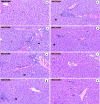Unveiling the potential anticancer activity of Spirulina maxima extract-nanoemulsion through in vitro and in vivo studies
- PMID: 39762303
- PMCID: PMC11704349
- DOI: 10.1038/s41598-024-82924-4
Unveiling the potential anticancer activity of Spirulina maxima extract-nanoemulsion through in vitro and in vivo studies
Abstract
Being the second leading cause of death globally, cancer has been a long-standing and rapidly evolving focus of biomedical research and practice in the world. Recently, there has been growing interest in cyanobacteria. This focus is particularly evident in developing innovative anticancer treatments to reduce reliance on traditional chemotherapy. This study investigates the anticancer potential of the Spirulina maxima extract nanoemulsion (SMNE) technique to improve the delivery, stability, and solubility of the S. maxima extract (SME). SMNE, prepared in three concentrations (SMNEC1, SMNEC2, SMNEC3), was characterized and confirmed to successfully load SME into silica-coated nanoparticles. Cytotoxicity tests on HepG2 and MCF-7 cell lines revealed a significant reduction in cell viability after 48-hour SMNE treatment, with IC50 values of 1488 µg/mL and 1721.936 µg/mL, respectively. SMNE also demonstrated efficacy in inhibiting tumor growth in mice with Ehrlich ascites carcinoma, normalizing alanine aminotransferase (ALT) and aspartate aminotransferase (AST) levels, and reducing oxidative stress markers such as catalase (CAT) and malondialdehyde (MDA). Histopathological examination showed that SMNEC3-treated groups had almost normal liver architecture. Additionally, SMNE downregulated oncogenic miR-221-3p and miR-222-3p, activating cancer suppression genes p27 and PTEN. The study concludes that SMNE, with its anti-inflammatory and antioxidant properties and ability to modulate key miRNAs, enhances SME delivery and shows promise as an effective cancer treatment.
Keywords: EAC model; Gallic acid; HepG2 cells; MCF-7 cells; miR-221-3p; miR-222-3p.
© 2025. The Author(s).
Conflict of interest statement
Declarations. Competing interests: The authors declare no competing interests.
Figures












Similar articles
-
Dioon rzedowskii: An antioxidant, antibacterial and anticancer plant extract with multi-faceted effects on cell growth and molecular signaling.Int Immunopharmacol. 2024 May 10;132:111957. doi: 10.1016/j.intimp.2024.111957. Epub 2024 Mar 29. Int Immunopharmacol. 2024. PMID: 38554441
-
Cryptolepine Analog Exhibits Antitumor Activity against Ehrlich Ascites Carcinoma Cells in Mice via Targeting Cell Growth, Oxidative Stress, and PTEN/Akt/mTOR Signaling Pathway.Anticancer Agents Med Chem. 2024;24(6):436-442. doi: 10.2174/0118715206274318231128072821. Anticancer Agents Med Chem. 2024. PMID: 38305388
-
Piper nigrum ethanolic extract rich in piperamides causes ROS overproduction, oxidative damage in DNA leading to cell cycle arrest and apoptosis in cancer cells.J Ethnopharmacol. 2016 Aug 2;189:139-47. doi: 10.1016/j.jep.2016.05.020. Epub 2016 May 10. J Ethnopharmacol. 2016. PMID: 27178634
-
Nanoparticle engineering enhances anticancer efficacy of andrographolide in MCF-7 cells and mice bearing EAC.Curr Pharm Biotechnol. 2012 Dec;13(15):2669-81. doi: 10.2174/138920112804724855. Curr Pharm Biotechnol. 2012. PMID: 23072387
-
Advances in delivery methods of Arthrospira platensis (spirulina) for enhanced therapeutic outcomes.Bioengineered. 2022 Jun;13(6):14681-14718. doi: 10.1080/21655979.2022.2100863. Bioengineered. 2022. PMID: 35946342 Free PMC article. Review.
References
-
- Organization, W. H. WHO Report on Cancer: Setting Priorities, Investing Wisely and Providing Care for All. (2020).
-
- Llovet, J. M. et al. Hepatocellular carcinoma. Nat. Rev. Dis. Primers7, (2021). - PubMed
Publication types
MeSH terms
Substances
LinkOut - more resources
Full Text Sources
Research Materials
Miscellaneous

